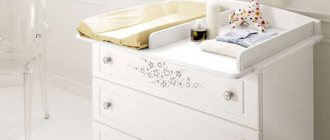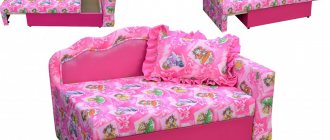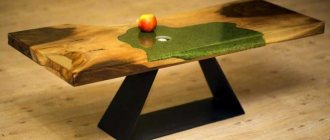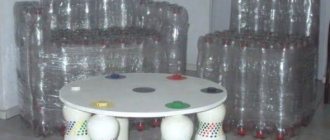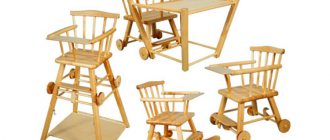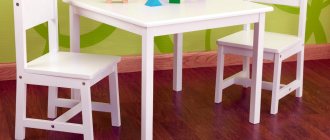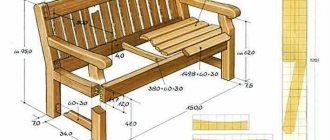In apartments and private houses, designers often use zoning. The living room and kitchen combine well. Two rooms connected to each other look spacious, and this layout will make the space cozy. You can update the design, implement interesting ideas, or repeat a design seen in a magazine, TV show, or photo on the Internet. The style in the living room-kitchen can be different, and choosing it can turn into an exciting experience. Before combining rooms, designers advise taking into account the basic rules, creating a project, choosing colors.
Zoning
Designers do not advise giving in to fashion trends and copying design ideas without taking into account dimensions, location and other nuances. Before planning and arranging furniture, every detail is thought through. There are several simple rules that experts advise you to follow:
- Let the room have natural light. To do this, remove excess walls (except for load-bearing ones).
- If the rooms in the apartment are small (12 sq. m or 16 sq. m), the layout of the kitchen combined with the dining room will be the right solution.
- If the ventilation system is not designed correctly, the smell of food will spread throughout the apartment.
Types of children's high chairs
Several types of chairs have been developed for children, depending on the purpose and age of the user:
- a miniature chair with a table - the same set as for adults. Suitable for children who are already one and a half to two years old. It is made of wood, plastic, sometimes has metal legs and other parts, and is equipped with seat belts;
- the hanging version is one of the types of folding, indispensable when there is very little space in the house. The design of this chair is a metal frame with a hard seat and back, equipped with a removable soft cover. The product is mounted to an “adult” table using clamps, using the lever method or with screws. The item is convenient to take with you on trips - it takes up little space, weighs between three and five kg, is suitable for children from six months old, and can withstand weight up to 13-16 kg;
- A travel high chair is not a chair in the usual sense, but rather a fastening system with seat belts that prevents the baby from falling. The product is attached to a large chair with a back and a hard seat. It is prohibited to place the item on stools or bar structures;
- tall folding models - when folded, they take up minimal space, are easy to assemble and disassemble, and weigh up to five kg;
- transformable chair - the largest option takes up approximately one square meter. The seats are easy to clean, the tabletop is removable and equipped with sides. Belts are not always available. The height levels range from one to seven so that the product can easily be adjusted to any table height. When the child has grown up, the structure is dismantled to obtain a free-standing table and chair;
- multifunctional - a type of transformer that serves as a high chair, swing, rocking chair. It folds and unfolds easily, takes up relatively little space, is made of plastic or wood, has stands for bottles, cups, a foot rest, and a table top. Some models have a function for changing the backrest tilt and footrest height. The product is suitable for children from one to five years old.
Partitions
The interior of the kitchen and living room begins to be thought out from the junction of two zones. Here are some of the methods and objects that delimit the space: installing a bar counter; a kitchen island; a large table; installing a low partition. Designers advise installing a wide counter, since you can sit at it like at a regular table, and high chairs are quite suitable for the whole family. However, in small rooms (16 sq m), narrow counters are installed. Kitchen islands are convenient to use, but are only suitable for large kitchen-dining rooms (25 sq m or 30 sq m). Capital low partitions are installed only if it has been decided in advance what they will be used for (for example, as a TV stand).
DIY children's table: light and comfortable
Children love to draw - especially while sitting on the floor or on the sofa. Everything would be fine, but they sit in crooked positions, which are not at all useful for the normal development of their growing organisms.
My name is Evgeny Kudryavtsev. I am an architect and the father of a little girl Irishka, for whom I invent toys and objects from cardboard and scrap materials. One day, when I saw how my daughter was once again creating, bent over in the shape of the letter “zyu,” I thought that it was simply necessary to make a special table for her.
You will need completely ordinary materials that can be found in any home:
- Stationery knife
- Ruler (preferably metal)
- Simple pencil
- Regular compass
- Glue "Moment" or PVA
- Cardboard box
- Cardboard tubes
1. Mark the cardboard with a pencil and cut out one piece with a knife, measuring 55x31 cm. Then we cut off the corners of the piece with a radius of 5 cm. Round corners are good because they are safe for children and do not wrinkle when the table is thrown or dropped. Which is important - because the table is light, and children will throw it. Lastly, mark with a compass and cut out holes for the legs. These holes should coincide in diameter with the diameter of the tubes - mine are 5.5 cm in diameter. Using the first part as a template, trace it with a pencil and cut out three more identical parts.
2. Now, using the same template, you need to cut out the table cover without holes and select cardboard tubes of the required length. Cardboard, both for parts and for the lid, should be strong, corrugated and preferably three- or five-layer. As a rule, household appliances or furniture are packaged in boxes made of such cardboard. And roll paper is usually wound onto such tubes.
Advice:
If it is difficult for you to get tubes from paper, then you can use tubes from cling film or baking foil. Only they will be smaller in diameter and this must be taken into account when marking the holes for them.
3. Using glue and a press, glue the three template layers together and try on the tube legs. In my case, the legs came out 13 cm long - so that the table top is located just above the legs of the sitting child.
Advice:
By the way, if the tubes do not immediately fit into the holes, then you can straighten the holes with sandpaper. Just don't overdo it! The tighter the tube fits into the hole, the more firmly it will hold.
4. After trying on the tubes, stick a lid on top, which you can then somehow decorate. I just stuck on a white self-adhesive film: it washes well and can always be changed if necessary. In addition, the child happily draws right on the table, and then I cunningly wash his masterpieces with a damp cloth.
5. View before final assembly. The layers and the lid are glued together, the tubes are of the required length.
Advice:
To carefully cut a fairly thick cardboard tube, you must first draw an even cutting line in the right place, and then, rotating the tube in your hand, slowly cut the cardboard along the line, all the time increasing the pressure.
6. Well, now all that remains is to glue the tube legs - and our table is ready. Now you can decorate it or leave it in its natural cardboard form.
Advice:
It is best to apply glue not to the walls of the holes, but to the bottom and at the same time to the walls of the tubes. Please keep in mind that some types of glue have a specific odor and can be toxic to small children - carry out gluing work in a ventilated area. After complete drying, the glue ceases to be dangerous.
Now on this table you can draw, sculpt or do other creative work - both on the floor and on the sofa. I deliberately did not cut through the lid and make cups for felt-tip pens from the tubes, which was possible: after all, if a child kicks the table or accidentally falls on it, it is necessary that all sharp objects immediately roll off without causing harm.
The table turned out to be light, safe, easy to create and use. A child (mine, for example, 13 kg) can easily stand on it and even jump.
This table can also be useful for adults. For example, for a romantic morning with your beloved - to serve coffee or a whole breakfast in bed. Or for workaholics who need a laptop stand to keep it cool.
Furniture items
A few examples of furnishing a kitchen combined with a living room:
- 1. Sofa. It becomes an object that zones space. The sofa is placed with its back facing the place where food is prepared. In small rooms (less than 20 sq m) a corner is placed, which is placed against a wall installed perpendicular or parallel to the kitchen.
- 2. Set. According to designers, minimalist models without elaborate details look modern. The service, vases or glasses are placed on an open shelf. You can buy a fashionable display case for them. Furniture is placed near the wall. If the space is large (20 sq. m, 25 sq. m or 30 sq. m), then in the central part you can install an island, which also has sections for kitchen appliances.
- 3. Furniture set. The style should be combined with the design of both rooms. In small rooms, a compact table and chairs made of transparent material or painted in light colors look good. You can add a table with a round top to your living room interior. In spacious rooms, the kit is installed near the wall or in the central part. An elongated rectangular dining table would look good here.
Read here: DIY table made from cut wood - stylish and original ideas for creating tables and ideas for choosing their design (140 photos)
How to make a children's table out of wood
You can purchase all the necessary materials for constructing a table in a carpentry shop. You need to order a tabletop, 4 bars for making the power body and 4 blanks for the legs of the future table.
Before you start making a wooden table for a child, make sure you have the following tools on hand:
- Electric drill with a set of special attachments for wood.
- Wood hacksaw.
- Hammer.
- Clamp.
- Sharp knife.
- Sandpaper.
- Wood glue.
- Ruler, tape measure, square.
Diagram of the table arrangement.
Having received the wooden blanks and collected all the tools, you can start working. First of all, take measurements of all the details of the future table. Use a square to check the accuracy of the corners of the panel for the tabletop, and use a tape measure to check the equal length of the legs and bars for the power body.
The height of the table largely depends on the chair on which the child sits. Your child's back should be straight when working at the table. Tables for adults begin to be made with a height of 70 cm, while a children's table, made by hand, is made with a minimum height of 55 cm.
Related article: How to build a country shower with your own hands
Using a hacksaw, trim the legs of the table, trying to make them the same length. Carefully clean the sawed areas with sandpaper so that no burrs remain. Use an electric drill to make grooves in the legs: clamp them with a clamp and use a drill to make one hole in the end of the part, and then use a cutter at low speed to make a rectangular groove. The same action must be done with all the other legs.
Then the depth of the resulting grooves needs to be measured. We take the bars from which the power frame of the table will be made, and measure with a ruler on each segment equal to the depth of the grooves on the legs. Check that all four bars are the same size; if you find a difference, remove it with a hacksaw.
After this, file the bars on all sides. Use a sharp knife to remove any unnecessary wood, making the joint part shaped to fit the rectangular grooves.
Assemble the base of the future table without fastening, connecting all the prepared parts together. Using a square, make sure that all angles are accurate - they must be straight. If necessary, swap some of the components to obtain a complete structure.
Scheme of a wooden round table.
Before disassembling the base into pieces, make notes on the correspondence of the grooves and legs. Now you can lubricate the joint elements with wood glue and assemble the finished base of the future children's table.
Then you can screw the tabletop to the base. First, place it face down on the floor, and place the finished base on top. Mark the areas where the legs meet the panel. In each resulting square, it is necessary to drill a hole for a furniture tenon strictly in the center. Apply glue to these tenons and secure them into the tabletop. Place the base on top.
The DIY table is ready! Now your child can draw without harm to his health.
Return to contents
Multi-level floor
To zone the space, craftsmen install floors at different levels. They advise installing a podium to separate the kitchen and dining room. This option is considered one of the most practical because, among other things, the owners have additional free space where they can hide something. It is convenient to use boxes or drawers for this. Wicker baskets will look good. But such space can remain free.
For podiums, reliable materials are selected that can withstand heavy loads. Usually builders make wooden or metal podiums.
However, such a design should not be made if there are small children in the family, since the podium can become an obstacle for him. In addition, various floor coverings can be used. They will zone the space between the living room and the kitchen and protect the podium from damage. For example, tiles are laid in the kitchen area, and laminate flooring in the dining room. The main thing is to choose colors and textures and combine the finishes correctly.
Desk for two schoolchildren
If two schoolchildren live in one room, then it is necessary to provide each of them with a comfortable study place. We will consider the option of making a comfortable design for two with our own hands.
In the process we will need the following:
- chipboard sheets;
- fiberboard sheets (for the bottom of drawers);
- drawer guides;
- nails;
- screwdriver;
- drill;
- building level
- self-tapping screws
Step-by-step instruction
Step one: we will need to cut the chipboard to the required dimensions, which will depend on the dimensions of the room. Refer to the pictures below to create your own unique drawing.
The finished design will look like this:
Important point! Chipboard parts often become chipped when cut by an inexperienced craftsman, so it is better to entrust this process to specialists in a furniture workshop. When all the parts are ready, we can begin assembly.
Step two: start work by assembling the table drawers. We need to drill holes in the sidewall, retreating 9 millimeters from the edge. There will be four holes in total for self-tapping screws, and the diameter of the drill in this case will be 3 millimeters. Such holes must be made in all parts of the future box.
Making holes
Step three: now you need to start screwing the self-tapping screws (insert them not all the way at first). Now you need to connect the parts together using these screws - even a beginner can handle such actions.
Upon completion of assembling the frame of the box, it is necessary to measure its diagonals - they should be equal
Step four: Now we need to nail the fiberboard bottom to the box using small nails. The nails should be driven in carefully, but with force, to securely fix the bottom.
The distance between the nails will be about 10 centimeters
Step five: you need to mark the location of the guides on the cabinet itself. To do this, you should attach the front parts to the top and put marks, so that the drawers will slide out without any obstacles. It is better to mark these lines with a simple pencil, after which they will need to be duplicated on the other side.
The bottom line, if there is a base of 7 centimeters, will be at a distance of 15 centimeters from the edge
Step six: you need to screw the guides onto the cabinet. In this case, collapsible telescopic guides were used.
Now they should be screwed exactly according to the marks using self-tapping screws
From the very edge you need to leave an edge of approximately 1 millimeter.
The main thing is to screw the guides so that they are in the same line
Depending on the opening method, there are ball and roller guides. The first ones allow you to open the drawer to its full depth, therefore they are considered more convenient. Read more about installing guides in a special article.
Step seven: at the bottom of the cabinet, attaching the base part, you need to make holes for the screws.
It is necessary to retreat 9 millimeters from the base, and then drill holes.
From the other edge you will need to retreat about 3.5 millimeters
Now you need to assemble the base. In this case, we will fix the drawer, because this is a great way to save chipboard and such a measure will be quite sufficient for the stability of the desk. Next, we need to screw the back, bottom and top drawers to our structure using self-tapping screws.
Assembling the base
Step eight: assemble the remaining parts of the cabinet.
Since we will not have handles, but only recesses, it is necessary to retreat about 2-3 centimeters from the front edge
We connect the sides of the cabinet with self-tapping screws
Step nine: the next step is to embed the “thrust bearings”.
This can be done using an 8 mm drill. The main thing is not to run into the screws that we secured earlier; you need to drill in the place that will be most convenient.
Making holes
The thrust bearings will be adjustable. This is necessary so that they can then be set according to the required parameters.
We hammer the thrust bearing into the hole. The hat must be removed for a while. This is done so that a piece of chipboard does not break during transportation of the product.
Hammering the thrust bearing
Step ten: now you need to screw the guides onto the drawers of our design. To do this, we first mark the mounting location with a ruler and pencil.
Making the markings
Next, all that remains is to screw the guides into the prepared holes using self-tapping screws. You need to start with the oblong holes to adjust their location.
Now all that remains is to insert the drawers, and you need to fasten the facades to them
Prices for a construction magnetic bracelet
Construction magnetic bracelet
Step eleven: now a tabletop with a support is installed on this structure and the table is ready.
Using the same principle, you should make another table, and then connect the structures in the corner
Step twelve: the table can be decorated if desired.
Video - Simple desk: manufacturing process
Loft
This year the style remains in demand. It is often used to equip kitchens combined with a living room. This combination gives more free space, which will only emphasize all the details of the loft.
Today, such a definition as “classic style” is used less and less by designers. Loft - any interior design in which various technical elements are not hidden, but emphasized.
For example, stylists play with brickwork, wires or concrete walls. The photographs clearly show how successful it can look like a living room that is combined with a kitchen. For loft, rough and heterogeneous surfaces and rough materials are selected. In apartments decorated in this style, wall lamps are installed. In this case, the light is directed along the walls. Due to this, shadows fall so that uneven surfaces look three-dimensional. At first, loft was viewed with caution, but it quickly became popular. Designers do not hide finishing materials and even fake them. To imitate a concrete surface and smudges, decorative plaster is used.
Preparation of the drawing
Making a highchair with your own hands involves using a detailed diagram. The drawing reflects all the elements, their sizes, connection methods, length, ratio. The design with clearly thought-out parameters and adjusted corners will fully correspond to the height and build of the child. For ease of work, you can use the standard sizes of the main parts:
- Support legs. The length of the elements can reach 20 cm.
- Seat frame connecting strips. The parameters should not exceed 20 cm.
- Back slats. The size is 20 cm.
- Seating options. The width and height of the seat should not exceed 20 cm. In the back area, the part can be mounted higher, but its dimensions should not exceed 30 cm.
Tables and chairs for children must have reliable support, so bars with a section of 5x5 cm are used to create it.
The dimensions of the furniture depend on the age of the child. All designs are divided into two large groups. The first is represented by products for the little ones. If you need to make a chair for feeding a child with your own hands, use standard parameters: height - 840–900 mm, back width - 450 mm.
Drawings and procedures for assembling a step stool with your own hands
The second group includes chairs, which are a smaller copy of furniture for adults. The height of the model in this case will depend on the growth indicators:
- height less than 85 cm - chair height 180 mm;
- 85–100 cm - 220 mm;
- 101–115 cm - 260 mm;
- 116–130 cm - 300 mm;
- 131–145 — 340 mm;
- 146–160 cm - 380 mm;
- 161–175 cm - 420 mm;
- more than 176 cm - 460 mm.
You can develop a sketch of the product yourself or use ready-made drawings that can be found on numerous construction sites. The best assistants in your work will be master classes with photographs and a detailed description of each procedure. It is worth checking first whether the sizes presented in the diagram are suitable for the child. If not, the height and width are increased or decreased in proportion so that the stability of the structure is maintained.
Creating a drawing yourself involves preparing images of each element with dimensions, type of material, connection methods, and types of fastenings. To avoid possible mistakes, it is recommended to make a test version using construction cardboard. This will help calculate the proportions and clarify the stability of the future product.
Provence
The name of this destination comes from a region in the south of France. Even a small kitchen-living room, the decor of which was inspired by French aesthetics, will be filled with warmth and comfort.
The main thing is that it has a lot of daylight, textiles with romantic prints, and floral patterns. The dining room in the Provence style is designed in pastel shades. Furniture items can be vintage or artificially aged. Plain walls will contrast with large checkered curtains. The door in the kitchen area set is sometimes replaced with curtains made from the same material as the tablecloth. A good addition would be vases and figurines, clay pots, forged metal parts and ribbons.
Decoration of the structure
A wooden chair made independently needs a protective coating that will reduce the negative impact of external factors. Most often, varnish is used for this. Experts recommend giving preference to acrylic compositions that can withstand any pranks of children. There are other ways to decorate furniture:
- wood carving;
- applications;
- applying all kinds of drawings.
Making and assembling a folding chair with your own hands, decor options
High chairs for children are usually painted with bright colors. Select pleasant, cheerful shades. The only condition is that they should not irritate. Muted green, yellow, coral, blue, and beige tones are optimal.
The paints should not contain heavy metals or toxic compounds. Regular interaction with these components can negatively affect the health of a growing organism.
You should not decorate a hand-made chair with massive voluminous decorations. This often leads to injury. It is better to use painting, hand or stencil. Little children will love applications and images of their favorite fairy tale and cartoon characters.
A children's chair made of plywood with the addition of curly legs looks interesting. Various images are often cut out on the back with a jigsaw. A bright and unusual stool will definitely please your baby, who will happily sit on it, eat or play.
Before assembling the high chair, you should check the age and height of the child, create or select a suitable diagram, and prepare the necessary materials and tools. You can make original transformers, stools, and folding models with your own hands using detailed master classes. Painting, wood carving, and drawing will make the furniture even more attractive to the baby.
Color combinations
Stylists advise taking into account the following nuances:
- direction in the interior;
- combination of shades;
- illumination
It is much easier to choose a palette if the style for the kitchen and living room has already been selected. For example, neoclassicism and Provence have their own combinations. In a classic interior, designers combine pastel colors, pale colors, which are slightly diluted with dark shades. In French country houses you can often see soft blue, pink, and pistachio colors. Art Deco designers make up objects and finishing materials in black and white, sometimes beige and brown or silver and black. The main thing is to choose a shade for the walls. White will become universal, it will expand the space, and later you can paint them with any paint. However, in the cooking area, white ceases to look fresh. Beige or gray shades would be more practical. This background will highlight the other colors. In a monochrome interior, designers recommend gluing wallpaper in an unusual color or with a photo print.
Waterproof surfaces are easy to clean, so washable wallpaper is recommended. The colors of the furniture echo the details and accessories, be it cushions for the sofa, curtains or other items.
